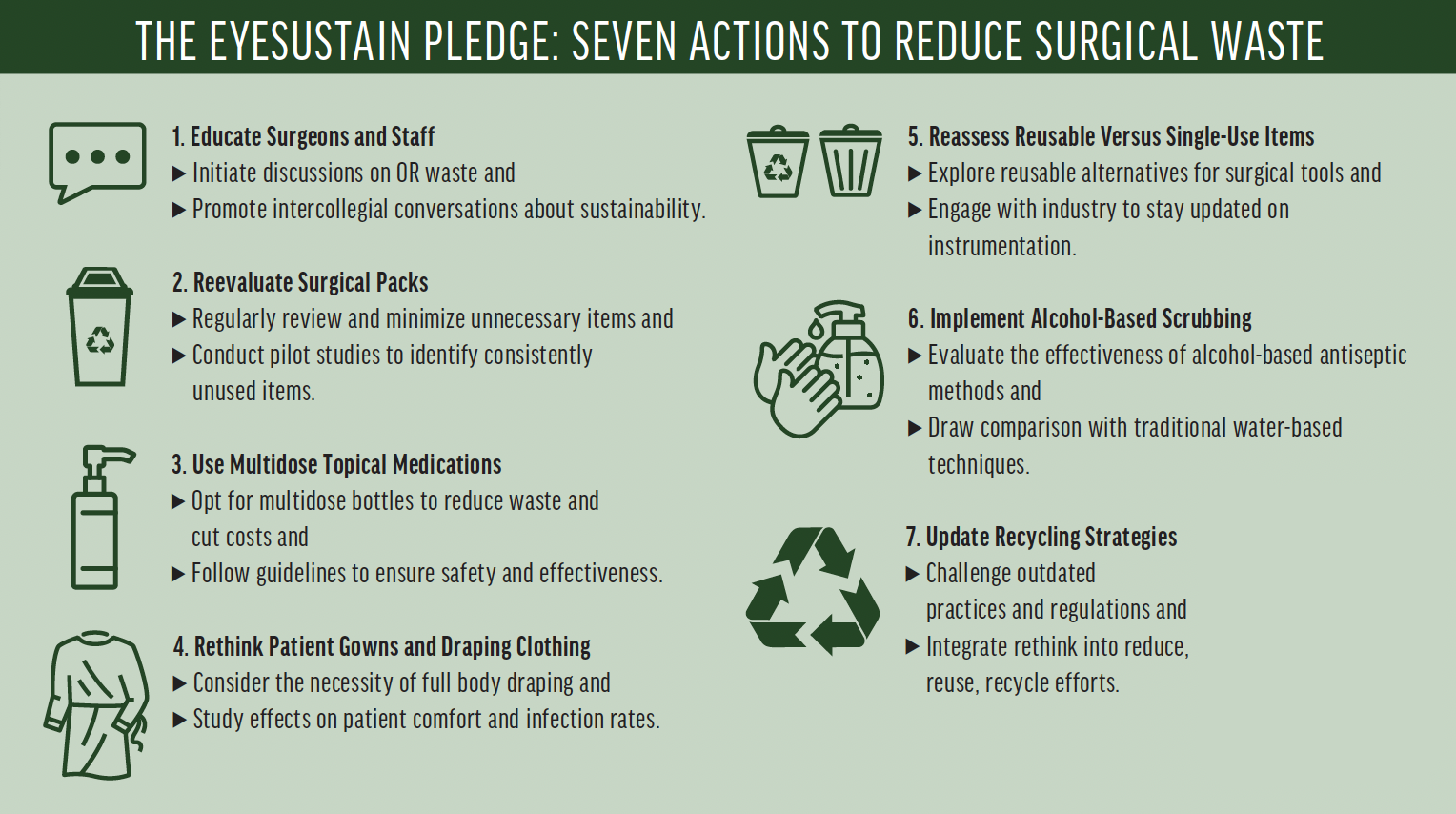

Climate change is the single greatest threat facing humanity.1 The environmental impact of eye care delivery and its role in climate change are well known.2,3 ORs and clinics generate excessive waste. As an ophthalmologist, you can be a catalyst for change, but you may be unsure how to begin. The first step is taking the EyeSustain pledge (click here to access the pledge) to embrace sustainability and tackle the challenge of surgical waste head-on. With this pledge, you commit to taking seven actions.
ACTION NO. 1: EDUCATE SURGEONS AND SURGICAL STAFF ABOUT THE SUSTAINABILITY AND IMPACT OF OR WASTE
As a surgeon, you influence the decision-making process in the OR. Start a conversation about OR waste with your team. Engage other surgeons in conversation about the topic. Intercollegial communication is a key first step in addressing the growing climate crisis.4
ACTION NO. 2: REGULARLY REEVALUATE SURGICAL PACK STANDARDIZATION TO MINIMIZE WASTE
Each surgical pack comes with a list of contents. Review the pack items with your team. Challenge yourself to remove items that are not used routinely and could be opened when needed. You might start with a pilot study to track the items that consistently remain unused over a 2-week interval. If you can operate without it, then get rid of it.
ACTION NO. 3: USE MULTIDOSE BOTTLES OF TOPICAL MEDICATION WHEN POSSIBLE
Multidose bottles of topical medication can be used with multiple patients safely and effectively. Guidelines are available in the published literature.5,6 In the current era of drug shortages, this action has become a high priority, and the individuals who stand to benefit the most from it are the patients. Transitioning to multidose regimens can also dramatically cut costs for the institution.7
ACTION NO. 4: ASSESS THE NECESSITY FOR PATIENT GOWNS AND FULL BODY DRAPING
Eliminating full body draping for surgery reduces a significant amount of paper waste. A large retrospective analysis at Aravind Eye Hospitals showed no difference in endophthalmitis rates between patients who wore hospital gowns and those who wore their own clothing into the OR.8 Eliminating patient gowns and full body draping can also improve patients’ overall experiences and comfort during surgery.
ACTION NO. 5: REGULARLY REASSESS OPTIONS FOR REUSABLE VERSUS SINGLE-USE PRODUCTS AND INSTRUMENTATION
Many single-use products have reusable alternatives that do not compromise procedures, workflow, or outcomes. Talk with your colleagues to see what they are using. Speak with industry and manufacturer representatives to keep abreast of changes in surgical instrumentation. You may be pleasantly surprised to find that the number of reusable tools available is increasing and develop a preference for them over their single-use counterparts.
ACTION NO. 6: ASSESS THE FEASIBILITY OF ALCOHOL-BASED SURGICAL SCRUBBING FOR ANTISEPSIS
Alcohol-based scrub techniques are safe and effective,9 yet many practices use water-based scrub antisepsis with chlorhexidine or povidone-iodine. Transitioning to a waterless presurgical scrub can save more than $300,000 per OR per year.10
ACTION NO. 7: INSTITUTE OR UPDATE RECYCLING STRATEGIES
Rethinking can be added to the classic paradigm of reduce, reuse, and recycle. Many daily systems-based practices derive from recommendations and burdensome regulations that have long gone unquestioned. Wasteful practices may simply be a force of habit. You can apply pressure to change them.

CONCLUSION
By taking the EyeSustain pledge, you commit to a paradigm shift in your approach to surgical waste management. Whether you are looking to educate your team on sustainability in the OR or seeking guidance on transitioning to reusable products, EyeSustain offers comprehensive support that includes educational videos and references. The pledge can be completed online by an individual representing your surgical facility or department. Through education, a reevaluation of practices, and collaboration, you can significantly reduce ophthalmology’s environmental footprint while maintaining the highest standards of patient care.
1. Chang DF. Tackling the challenge of needless surgical waste in ophthalmology. J Cataract Refract Surg. 2023;49(4):333-338.
2. Chang DF. Needless waste and the sustainability of cataract surgery. Ophthalmology. 2020;127(12):1600-1602.
3. Buchan JC, Thiel CL, Steyn A, et al. Addressing the environmental sustainability of eye health-care delivery: a scoping review. Lancet Planet Health. 2022;6(6):e524-e534.
4. Sherry B, Lee S, Ramos Cadena MLA, et al. How ophthalmologists can decarbonize eye care: a review of existing sustainability strategies and steps ophthalmologists can take. Ophthalmology. 2023;130(7):702-714.
5. Jensen MK, Nahoopii R, Johnson B. Using multidose eyedrops in a health care setting: a policy and procedural approach to safe and effective treatment of patients. JAMA Ophthalmol. 2014;132(12):1476-1479.
6. Palmer DJ, Robin AL, McCabe CM, Chang DF. Reducing topical drug waste in ophthalmic surgery: multisociety position paper. J Cataract Refract Surg. 2022;48(9):1073-1077.
7. Berkowitz ST, Finn A, Sternberg P Jr, Patel S. Potential cost savings associated with a multiuse preoperative and preinjection eyedrop protocol. Ophthalmology. 2022;129(11):1305-1312.
8. Haripriya A, Ravindran RD, Robin AL, Shukla AG, Chang DF. Changing operating room practices: the effect on postoperative endophthalmitis rates following cataract surgery. Br J Ophthalmol. 2023;107(6):780-785.
9. Tsai JC, Lin YK, Huang YJ, et al. Antiseptic effect of conventional povidone-iodine scrub, chlorhexidine scrub, and waterless hand rub in a surgical room: a randomized controlled trial. Infect Control Hosp Epidemiol. 2017;38(4):417-422.
10. Javitt MJ, Grossman A, Grajewski A, Javitt JC. Association between eliminating water from surgical hand antisepsis at a large ophthalmic surgical hospital and cost. JAMA Ophthalmol. 2020;138(4):382-386.




